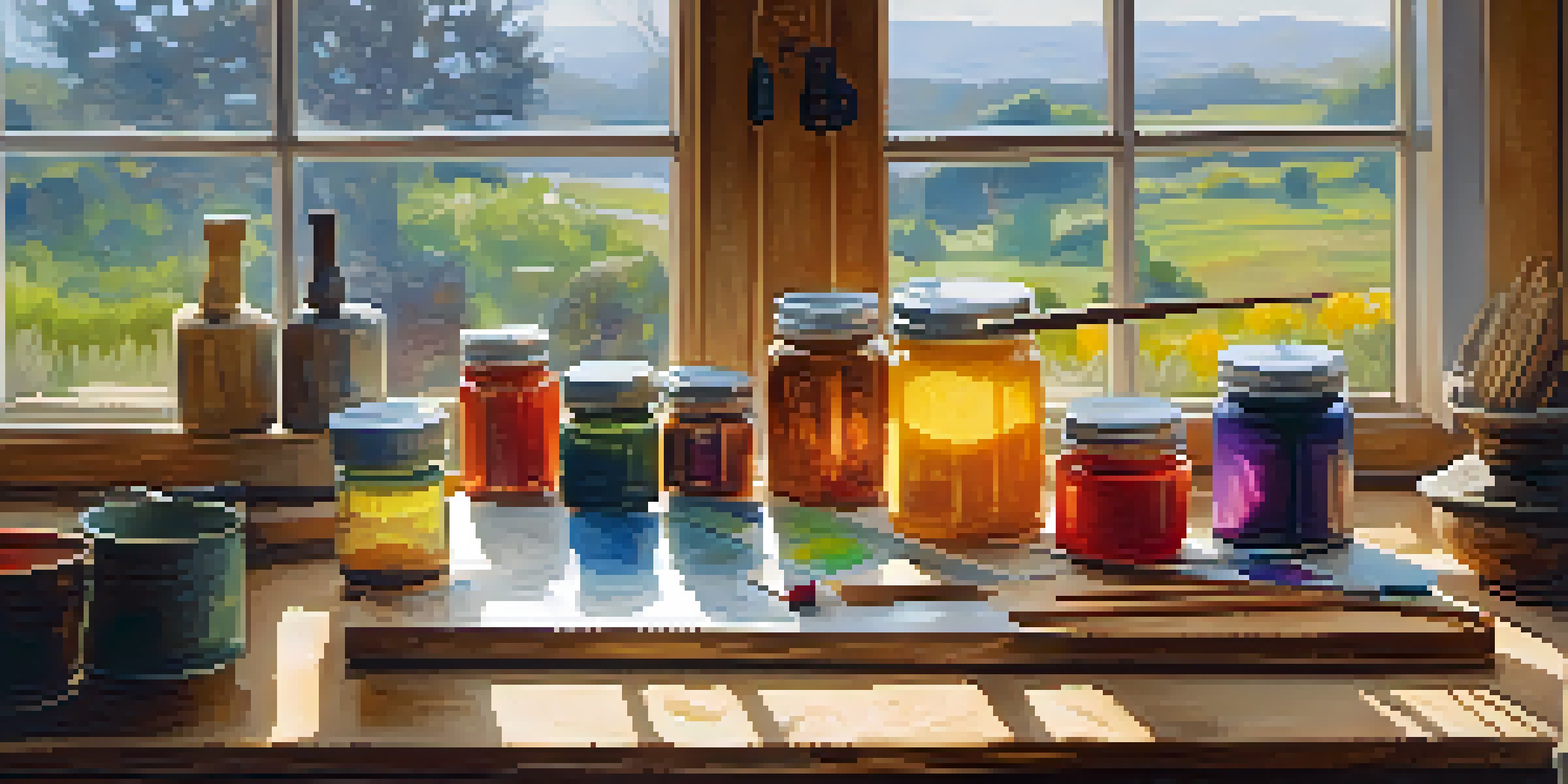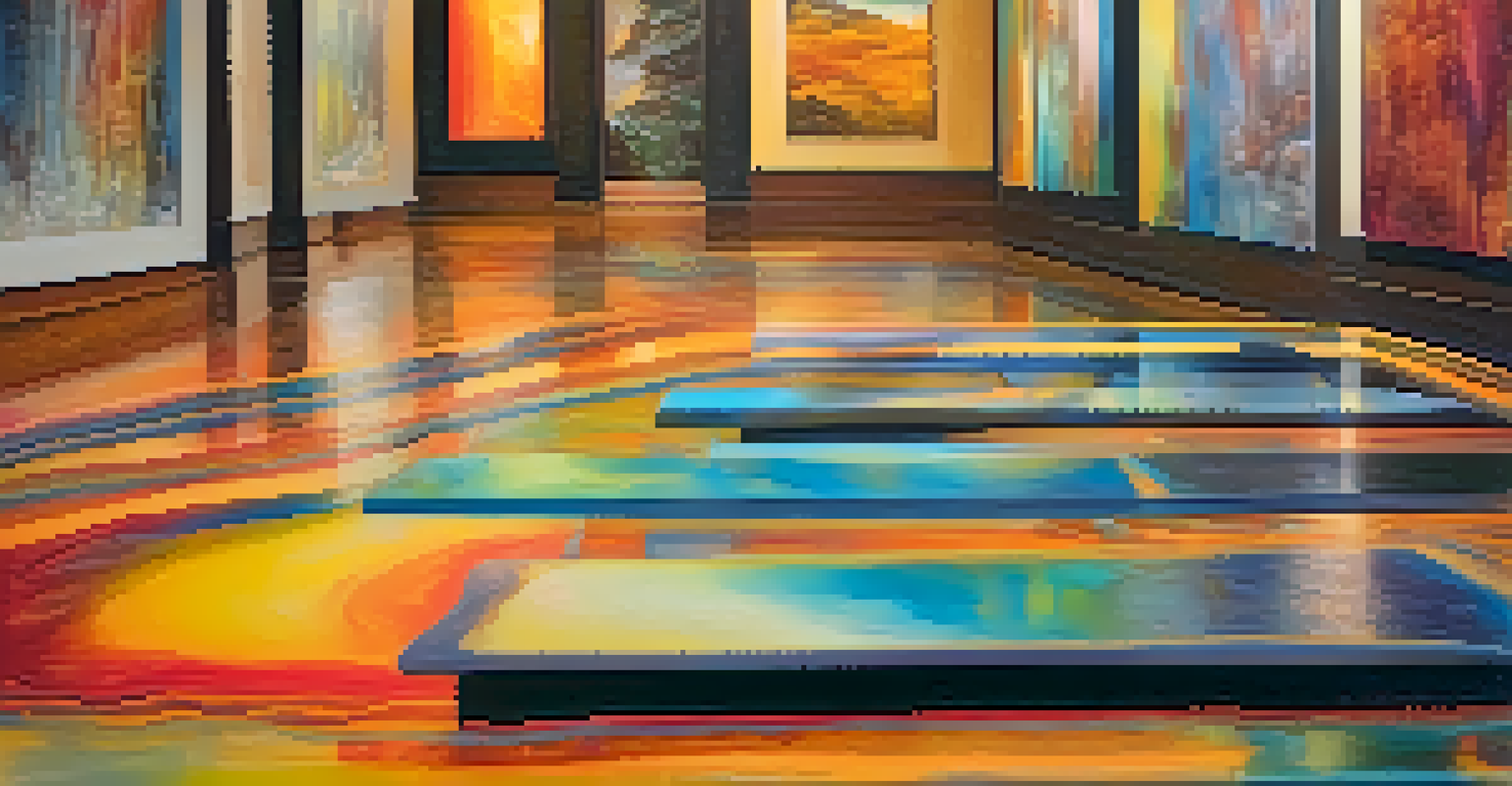Exploring the World of Encaustic Painting: Techniques and Tips

What is Encaustic Painting and Its History?
Encaustic painting is a fascinating art form that uses heated beeswax mixed with colored pigments. This ancient technique dates back to the Greeks who used it to decorate wooden panels and sculptures. The word 'encaustic' comes from the Greek word 'enkaustikos,' meaning 'to heat or burn in.' With a rich history that spans thousands of years, this medium has evolved but retains its allure and unique characteristics.
Art is the most beautiful of all lies.
The beauty of encaustic painting lies in its versatility. Artists can create stunning textures and layers, all while enjoying the dynamic nature of wax. It allows for both precision and spontaneity, enabling expressions that are both vibrant and tactile. This medium is not just a blast from the past; it's a contemporary choice for many artists today, making it relevant and exciting.
By learning about the history of encaustic painting, you can appreciate the depth of this art form. Understanding its roots helps artists connect with the techniques used by those before them, fostering a sense of community and continuity within the art world.
Essential Materials for Encaustic Painting
To embark on your encaustic painting journey, you'll need some essential materials. First and foremost, you'll require a heat source, such as a hot plate or a heat gun, to melt the beeswax. Next, invest in a good quality beeswax, which can be found in blocks or pastels, along with colored pigments to add vibrancy to your work. Having a palette and brushes specifically designed for wax will also enhance your experience.

Safety is paramount, so ensure you have proper ventilation when working with heated wax. This minimizes any harmful fumes and keeps your workspace pleasant. Additionally, using a heat-resistant non-stick surface can help in managing spills and drips during your creative process.
Encaustic Painting's Rich History
Encaustic painting, an ancient art form using heated beeswax and pigments, has evolved over thousands of years while maintaining its unique appeal.
As you gather your materials, consider the textures and effects you want to achieve. Different brushes and tools can create various finishes, from smooth to textured surfaces. Experimenting with your setup can lead to delightful surprises in your artwork, making the journey more enjoyable.
Basic Techniques for Beginners
Starting with encaustic painting can seem daunting, but mastering a few basic techniques will help build your confidence. One foundational method is the 'layering technique,' where you apply layers of wax and allow each to cool before adding the next. This builds depth and dimension in your artwork, allowing colors to blend beautifully.
Every artist dips his brush in his own soul, and paints his own nature into his pictures.
Another technique to explore is 'fusing,' which involves using a heat source to bond layers of wax together. This creates a unified surface and enhances the glossy finish that encaustic art is known for. Don't rush this process; taking your time ensures a polished outcome.
As you practice, don’t shy away from experimenting! Try creating textures with different tools or incorporating mixed media elements, like paper or fabric, into your wax layers. The beauty of encaustic painting is its flexibility, encouraging you to find your unique style.
Advanced Techniques to Enhance Your Art
Once you've mastered the basics, it's time to dive deeper into advanced encaustic techniques. One such method is 'incising,' where you carve or scratch into the wax to create intricate designs or textures. This adds a whole new dimension to your pieces, inviting viewers to explore your work up close.
You might also want to experiment with 'transfers' by applying images or text onto wax. This technique opens up opportunities for storytelling in your artwork, allowing you to blend imagery with your unique style. Just remember to seal your transfers properly to maintain their integrity.
Essential Materials for Beginners
Key materials for encaustic painting include beeswax, a heat source, and specialized brushes, all crucial for creating vibrant artwork.
Don't forget about the power of color mixing in encaustic painting. Combining different colored waxes can yield stunning results, and the translucence of the wax allows for layering colors that create luminous effects. Embrace the freedom of experimentation, as this can lead to unexpected and beautiful outcomes.
Tips for Successful Encaustic Painting
To achieve successful results in encaustic painting, remember to embrace the medium's imperfections. Wax can have its quirks, so rather than fighting them, learn to work with these characteristics. Sometimes, a 'mistake' can lead to a beautiful, unexpected outcome that enhances your artwork.
Regularly clean your tools and workspace to maintain the quality of your materials. Wax residue can build up and affect the colors and textures you create. A quick clean-up after each session will save you time and frustration in the long run.
Lastly, don't hesitate to seek inspiration from other encaustic artists. Joining workshops or online communities can provide valuable insights, tips, and support as you navigate your artistic journey. Sharing your experiences can foster a sense of belonging and encourage growth in your practice.
Incorporating Mixed Media in Encaustic Art
One of the exciting aspects of encaustic painting is its compatibility with mixed media. You can incorporate various materials, such as paper, fabric, or found objects, into your wax layers. This adds depth and intrigue to your artwork, making it visually captivating.
When using mixed media, consider how each element interacts with the wax. Some materials may absorb the wax differently or require specific techniques for adherence. Testing these combinations on smaller pieces can help you determine what works best before committing to larger works.
Exploring Mixed Media Techniques
Incorporating mixed media into encaustic art enhances creativity, allowing artists to blend various materials for richer, more dynamic pieces.
Ultimately, mixed media enriches your encaustic experience, allowing you to express your creativity in countless ways. The fusion of various materials can lead to unique narratives, making your art not only a feast for the eyes but also a conversation starter.
Caring for Your Encaustic Artwork
After pouring your heart and soul into your encaustic artwork, proper care is essential to ensure its longevity. Store your pieces in a cool, dry place away from direct sunlight, as heat can cause the wax to melt or distort. A well-maintained environment is crucial for preserving the vibrancy of your colors.
Cleaning your encaustic art requires gentle handling. Use a soft, dry cloth to dust your pieces and avoid any harsh chemicals that may damage the wax. Regular maintenance will keep your artworks looking fresh and beautiful for years to come.

If you ever want to refresh a piece, encaustic art can be reworked! You can heat it up and add new layers or colors, giving your artwork a second life. This characteristic of encaustic painting allows for continual growth and transformation, making it a dynamic art form.